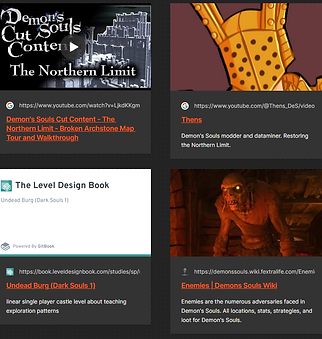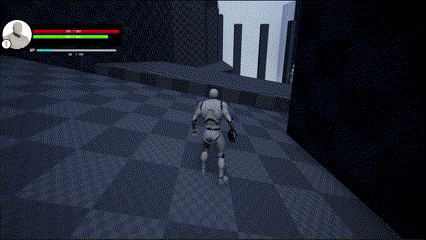
Demon's Souls 6th Archstone
The goal of this project is to create my own version of the deleted level from Demon's Souls, based on community research on the subject. The goal is to simulate my arrival mid-production, with a pre-established universe and mechanics.
Role: Level Designer
Year: 2024
Duration: 6 months
Software Used: Photoshop, Milanote, Unreal
Assets: Flexible Combat System


Presentation and context
The Souls-like genre is one of my favorites, and it's this genre that inspired me to specialize in level design. So, I wanted to create a level like this to put into practice what I love so much about these levels: the labyrinthine aspect, with mini-loops in the level design that make exploration so fascinating in these games.
Demon's Souls, created by FromSoftware and released in 2009 on PS3, is officially the first Souls-like (although it borrows many aspects from games like King's Field by the same studio). It features an entire level cut from the game due to lack of development time. Many elements of this level are still present in the game files, and dataminers share their findings with the community, which fuels the imagination of creators as to how this level could have been designed.
Documentation
So I had to gather all the known information about this cut level. I used Milanote to sort and preserve all this useful information for building my level.
The base game gives us very little information: this level is located in snowy mountains, inhabited by Giants who were in conflict with Humans. The Archstone allowing teleportation to this level was destroyed by these same Humans when the Giant kingdom was the first to fall to the Demon invasion.
This whole aspect of war between Giants and Humans, as well as the fact that this was the first kingdom invaded by Demons, will form the basis of my level. My initial idea was to keep the concept of the test map found in the game code, with a first part corresponding to the ascent of a mountain, and a second taking place in the ruins of a castle. It's impossible to know who owned this castle today, so I decided to make it a Giant City. This seemed more original to me compared to the rest of the game, but it also completely changes the architecture and size of this part of the level compared to the datamined map.



Tools
The major gray area of this project was the final blocking support. Should I modify the base game? Code or use an existing controller? On which engine?
I wanted to work on Unreal, and I got hold of a package containing a controller with a very advanced combat system similar to that of Demon's Souls. All I had to do was modify the blueprints of the various elements in this package to achieve a feel as faithful as possible to that of the original game.
The package also contains various enemies with AI, which gives me a great deal of freedom in level construction.
Research
Using dataminer discoveries, wikis, and various research and analysis documents on the game, I was able to create a first overview, along with some intentions, of what my level could look like.
As with the other levels in the game, it will be divided into three parts. As mentioned previously, an initial exploration phase in the mountains will highlight the city's isolation and illustrate the Giants' ability to master a hostile environment. This sequence will end with a boss, followed by the main part of the level, a very labyrinthine section with the famous Souls shortcuts. It will take place in a ruined portion of the Giants' city. Another boss will conclude this sequence and provide access to the level's Demon.
Since the entire documentation and research phase took a lot of time, I focused on the second part, the one located in the city, for my schematics and final blocking. You'll notice that I also created detailed plans for certain sections of the level. Having a background in drawing, I have gotten into the habit of illustrating my game sequence ideas to make them easier to visualize, both for myself and for the rest of the teams I work with. The goal of this project is to simulate my integration into a team in a production environment.




Paper verison
Based on my previous research, I created the paper version of the level. When designing it, I imagined that the player should feel overwhelmed by the architecture and that they were only exploring a tiny part of the city. They also needed to perceive the traces of the human invasion attempts. That's why I incorporated passages in the walls, created by the human soldiers during their assault. In addition, I surrounded the area with walls with the roofs of neighboring structures visible, to reinforce the idea that the universe extends far beyond the accessible areas.
I divided this area into several sections. Since the Giants were the first to succumb to the Demons, who feed on souls, I had the idea of integrating a gameplay objective based on the use of souls. The player will have to open a door visible upon entering the city by activating two soul receptacles. After an initial narrow sequence to cross a wall, the level opens onto an outdoor area serving as a "center." The player will then have to explore different towers to progress and find the pedestals to activate.
Blocking
For the blocking, I decided to use the size of the Giants in Elden Ring, also developed by FromSoftware, as a reference. The main challenge was maintaining a consistent scale between the player, the enemies, the Giants, and the architecture of the area.
The placement of enemies and objects was designed to encourage the player to observe their surroundings and avoid rushing into combat. The shortcuts were placed last, after timing the time it took to traverse the level and identifying the most difficult sections. The goal was for the player to feel relief and a sense of reward when activating a shortcut.
So I integrated a first shortcut halfway through, once the player reaches the first tower, allowing them to return directly to the fire. The second shortcut is located opposite the last tower, where the second pedestal to activate is located.



Balancing
I then had my level tested by players familiar with Souls-like games, and then by people less familiar with the genre. The goal was first to balance the number and placement of enemies, then to refine the shapes, sizes, colors, and lighting of the environment.
The main feedback from experienced players concerned the adaptation to the weapons available in Demon's Souls. Indeed, many enemies and sequences in my level could be easily defeated with magic or a bow, requiring adjustments to maintain the challenge.

This project allowed me to simulate joining a studio in full production mode and adapt to what was already established. I was also able to put into practice what I learned playing FromSoftware games, which influenced my decision to become a Level Designer.
It was also the first major project I worked on using Unreal Engine, which allowed me to master the various Level Design tools and some basic Blueprinting skills.

